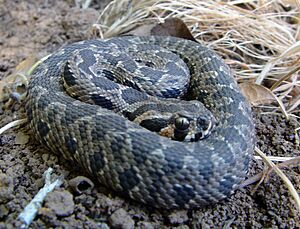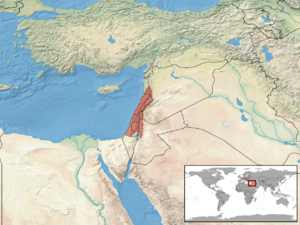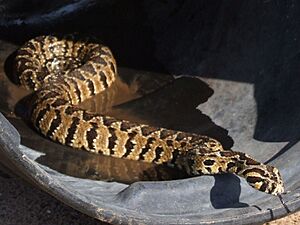Palestine viper facts for kids
Quick facts for kids Palestine viper |
|
|---|---|
 |
|
| Conservation status | |
| Scientific classification | |
| Genus: |
Daboia
|
| Species: |
palaestinae
|
 |
|
The Daboia palaestinae, also called the Palestine viper, is a type of viper snake. It lives only in the Levant area, which includes countries like Israel and Lebanon. Like other vipers, this snake is venomous, meaning its bite can be dangerous. It causes many snakebites in the places where it lives.
Contents
What Does the Palestine Viper Look Like?
This snake usually grows to be about 70 to 90 centimeters (27 to 35 inches) long. Some can even reach up to 130 centimeters (51 inches). Its head is shaped like a triangle and stands out from its neck. Small scales cover its head.
The snake's body has large, dark, diamond-shaped spots. These spots sometimes connect to form a zig-zag pattern.
Interestingly, there's another harmless snake called the coin-marked snake. It lives in the same areas and looks very similar to the Palestine viper. People often confuse the two. This is likely a case of Batesian mimicry, where a harmless animal copies a dangerous one to scare away predators.
Where Does the Palestine Viper Live?
You can find the Palestine viper in northern and central Israel, Palestine, western Syria, northwestern Jordan, and Lebanon. In 2017, one was even found in Turkey.
Scientists say its home is quite small. It mainly lives in the coastal plains and hills of Lebanon and Israel. It also lives in nearby parts of Syria and Jordan. The first place this snake was officially found and described was in Haifa, Israel.
Is the Palestine Viper in Danger?
The IUCN Red List of Threatened Species says this snake is of "Least Concern" (LC). This means it's not currently in danger of disappearing.
It has this status for a few reasons:
- It lives in many different places.
- It can be found in various types of habitats.
- There are likely many of these snakes in the wild.
- Its numbers are probably not dropping quickly.
Scientists are not sure if its population is growing or shrinking, but it's not considered threatened right now. This information was last checked in 2005.
How Dangerous is the Palestine Viper's Venom?
The venom of the Palestine viper is quite strong. Since the mid-1900s, there has been an antivenom to treat bites from this snake. This antivenom is considered safe and works well.
However, people can still die from its bite sometimes. About 0.5% to 2% of people who are bitten do not survive. In Israel, at least 7 people have died from this snake's bite since the year 2000.
The venom contains several types of chemicals that affect the body. These include:
- Chemicals that affect the nervous system (neurotoxins).
- Chemicals that cause bleeding (hemorrhagins).
- Chemicals that help blood vessels grow.
- Chemicals that stop blood from clotting.
Palestine Viper Life Cycle
These snakes usually mate around May. Unlike most other vipers, which give birth to live young, the Palestine viper lays eggs. This is called being oviparous.
The female snake lays her eggs around August. The baby snakes hatch from the eggs about 1.5 to 2 months later. Even when they are very young, these snakes can bite and kill their prey. Their venom system is fully developed.
The Palestine Viper in Culture
This snake might have been mentioned in ancient Egypt. A list of venomous snakes in the Brooklyn Papyrus, from around 1000 BC, may refer to it.
Some experts believe the snake called "Tsefa" (צפע) in the Hebrew Bible is this very snake species. In modern Hebrew, its name is "Tsefa Matsui," which means "common Tsefa."
During the first Gulf War in 1991, a secret code phrase was used in Israel. "Nahash Tsefa" (Viper Snake) was broadcast on radio and TV. This told Israeli citizens to put on their gas masks because of missile attacks from Iraq.
The Israeli Air Force named their Bell AH-1 Cobra helicopter "Tzefa." Also, the IDF's paratroopers battalion #202 is called the "Tzefa" Battalion.
In 2018, the Palestine viper was officially named Israel's national snake.



